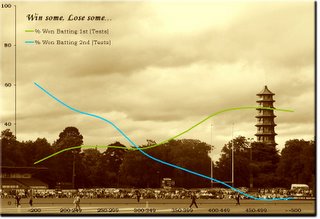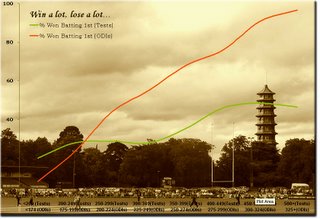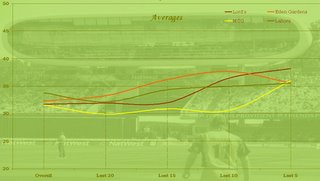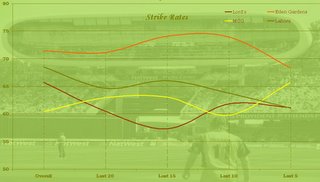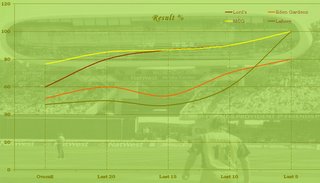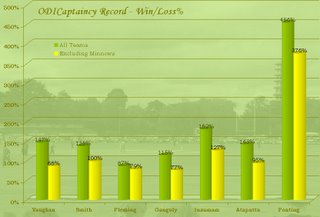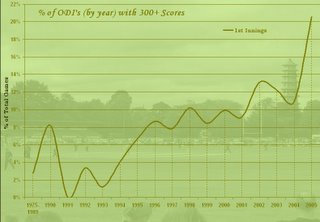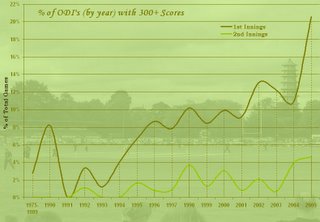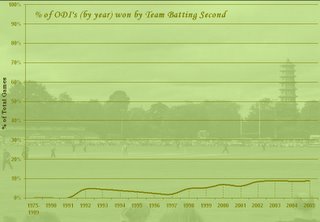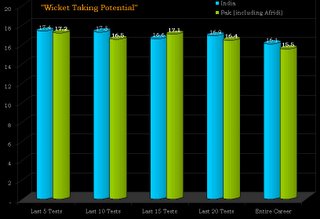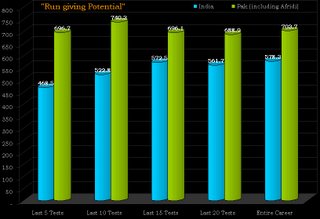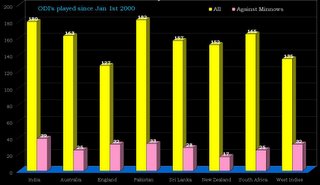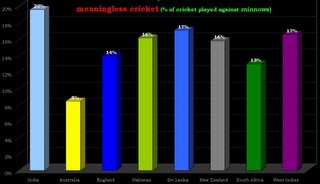
(click on image to enlarge)
And yes, in case you havent noticed, I am back...
but only briefly as I head to India for a much needed holiday!
Disclaimer: Statistics only tell me that Tendulkar is a Genius, Gayle a destructive batsman, and Australia a great team. Beyond that they mean nothing, else Don Bradman would score 99.96 runs every time he came out to bat…

 (Please click on this and other graphs to enlarge)
(Please click on this and other graphs to enlarge)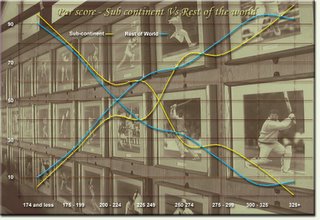

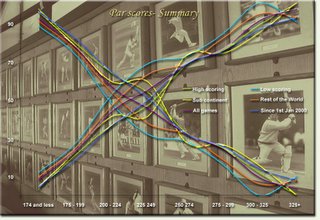


 (click on image to enlarge).
(click on image to enlarge).Like I said before, scheduling Test matches is a science, but rocket science…
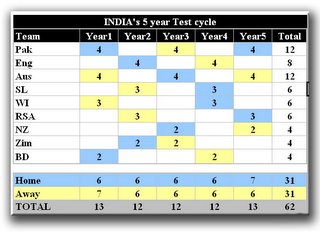
Anyway, this post is more to do about the One-Day game and less to do with Test cricket (though they are related in a vague sort of way).
Before reading any further, ask yourself this question; when you sit down to watch a one day game does a par score cross your mind, i.e., a score after the first innings that gives both Teams an equal chance of winning? And after the 1st innings is over, do you have a gut feeling as to who will win (or lose) the game? And are you more often right then wrong?
If the answer to all these questions is no, then you haven'’t watched enough one day cricket, but read on nevertheless J
And if the answer is yes, then welcome to the club. In this case, pick up a pen and paper and write down the rough par scores that come to your mind based on all* ODIs played:
- World wide since the early 70'’s
- World-wide since
- In the sub continent
- Outside the sub continent
* Excluding games decided by D/L (or similar) method, less than 45 overs (as they distort the numbers) and those that did not result in a +ve result (mainly due to rain, but occasional Ties)
I am looking for four answers here (one for each) but let me clarify, I do not expect anyone to come up with accurate answers. The main idea (apart from a bit of fun) is to see if such numbers do spring to mind.
Now to proceed. I had mentioned in one of my earlier posts that higher the 1st innings score, the more the chances of the team winning. As a refresher, here is the graph from that post (ignore the comparison with Test cricket for the moment) …
And since we know that in the one day game, unless there is rain interruption or a tie (which is very rare), if you are not winning, you are losing. If we exclude these '“No Result' games, the losing line is a mirror of the winning line, we get a graph in which the lines cross each other at the 50% mark (donating a point when the chance of winning or losing is equal, or at Par).
(Based on all* Games world wide)
And there is another striking aspect of the game; not only does the chance of winning (or losing) change dramatically once you move from the par score, the margins of victory (or defeat) also change dramatically.
(please note, I have used nr of balls left as the margin of victory if Team batting 2nd wins as opposed to the traditional wickets margin).
Now, in my opinion, these graphs highlight some of the most important attributes (and also flaws) of the One day game:
So the moment the 1stinnings score moves away from the par score, its starts becoming predictable move. So how many games finish around the par score and how many out side it?
As you can see, only about 25% -30% games do finish around the par score. So about 70-75% games finish outside the par score and the further they are from that score, the more one sided they get.
Now, in the ideal world, it would be great if all games finished around the par score. But that would mean that the 1st Innings would be come predictable and boring J We can'’t win, can we…
Anyway, got to rush now. Travelling, work etc will keep me away for a couple of days.
But don't throw away your tiny sheet of par scores as we still need to find out how the game has changed in the last few years and how sub continental games differ from elsewhere. And feel free to revise those scores. After all, there are no prizes for guessing correctly J
While I am in the middle of an analysis highlighting the virtues of Test cricket (over ODI’s), this (pitch) seems like a conspiracy against my blog.
Anyway, I am sure there is still hope that something can be done to put some life into the Lahore pitch like…
Any more suggestions?
